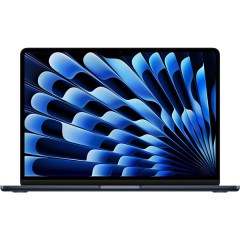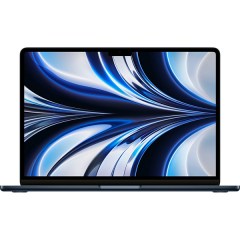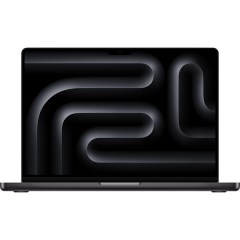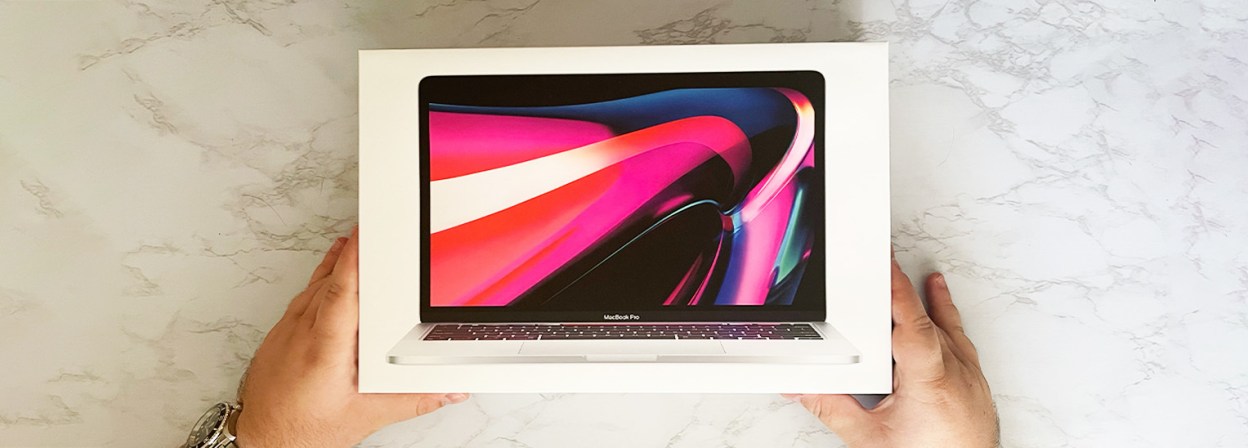BestReviews is reader-supported and may earn an affiliate commission. Details

Apple’s latest processor comes to the Air line in a subtle but appealing upgrade to its bestselling model.
Its powerful M3 processor increases performance while reducing energy use and heat generation compared to the M2. The bright, 500-nit Liquid Retina screen makes images look vibrant. Good 15 to 18 hours of battery life. Supports two external displays and fastest WiFi 6E.
Still has only four ports, including MagSafe power port and headphone jack.

A thin and light all-around crowd-pleaser of a laptop that’s great for daily computing.
This one hits the sweet spot of size, speed and portability. Features a bright 500-nit Liquid Retina screen. Good battery life of 15 to 18 hours on a single charge. Fanless. USB-C ports support DisplayPort and Thunderbolt 3 for expansion. Slim and light.
Supports only one external display and up to WiFi 6.

As good as its smaller sibling, but with a bigger screen, faster GPU and six speakers.
Bright 15-inch screen provides room for multiple windows or tabs. Supports two external displays, more than its predecessor. Fast M3 processor with 10-core GPU. Capable of WiFi 6E. New anodization seal minimizes fingerprints on Midnight color.
Has limited ports. It’s bigger and slightly heavier than 13-inch Air.

A high-priced powerhouse of a machine for filmmakers, photographers and other professionals.
M3 Max chip is the most powerful available from Apple. Packs up to 48 GB of memory and 4 TB of storage to edit feature-length video or manipulate huge datasets. Features big bright screen with adaptive refresh. Includes HDMI and SD card ports.
Very expensive. Not upgradeable after purchase. May be too large for some bags.

Pro-level power and specs in a smaller screen for high-end tasks on the go.
M3 Pro chip comes with at least 18 GB of memory for pro-level applications. Bright, color-accurate with adaptive refresh rates. Capacious storage options. Good 15- to 22-hour battery life. Offers HDMI and SD card ports.
Expensive. M3 non-pro model is underpowered.

We recommend these products based on an intensive research process that's designed to cut through the noise and find the top products in this space. Guided by experts, we spend hours looking into the factors that matter, to bring you these selections.

Apple’s MacBooks regularly top lists of the best laptops. Which are the best MacBooks, however, isn’t necessarily obvious. Apple makes at least five different models of MacBook in two separate lines, Air and Pro. Figuring out the best MacBook for you means finding out what they can do, knowing what you need them to do and how much you’re willing to spend.
With thin, seamless aluminum bodies, sharp, bright screens and Apple’s unmatched coordination of hardware and software, MacBooks are some of the best-performing and most enviable laptops available. BestReviews has tracked MacBooks from the beginning, digging into the pros, cons and innovations of each model over the years and testing them in our Testing Lab.
If you’re looking for a new Apple computer right now, we believe the brand-new MacBook Air 13-Inch with the M3 chip is the best MacBook for most people, while the popular 2021 model MacBook Air 13-Inch with M2 chip packs the most value for the price. But if you’re a creative professional, or on a budget, there are other MacBooks that might better fit your needs.
Product Specifications
Display Size and Resolution: 13.6” LCD, 2560 x 1664 resolution (224 ppi) | Processor: Apple M3 (4.05 Ghz, 8-core CPU, 8-core GPU) | RAM: 8GB unified | Storage: 256GB SSD | Battery Life: 15 to 18 hr
The best MacBook overall and the best MacBook for most people is the new MacBook Air 13-inch with the M3 chip. It stays at the sweet spot of screen size, portability and performance established by its lauded predecessor the M2 Air and should be more than enough for all but the most demanding users.
The MacBook Air 13-inch with M3 has a contemporary silhouette that manages to be even thinner than the thickest part of older wedge-shaped Airs. Its M3 processor improves on the performance of the previous generations of Apple’s M-series processors while being even more energy-efficient, allowing the 13-inch M3 Air to work without needing a loud and intrusive cooling fan.
Its 13.3-inch LCD screen gets as bright as 500 nits, plenty for work in all but the most brightly lit environments. It comes with 8 gigabytes of memory and starts with a 256GB SSD for storage. Apple says its battery can last at least 15 hours while wirelessly surfing the web, or up to 18 hours while watching video. While it has only two ports, they’re both USB-C and support ThunderBolt 3 and DisplayPort for up to two external displays with the lid closed. The 13-inch Air also has a power port featuring Apple’s easy-release MagSafe 2 charging cable, plus a headphone jack.
Best bang for the buck
Product Specifications
Display Size and Resolution: 13.6” LCD, 2560 x 1664 resolution (224 ppi) | Processor: Apple M2 (3.49 GHz, 8-core CPU, 8-core GPU) | RAM: 8GB unified | Storage: 256GB or 512GB SSD | Battery Life: Up to 18 hr
The 13-inch MacBook Air with the M2 processor debuted in 2021 and has topped best-of lists ever since. While the M3 version has superseded it with a more advanced and efficient processor, there are few things you can’t do with the M2 version that you can with the new M3.
The 13-inch M2 Air has the same design as the new M3 model, with a 13.6-inch Liquid Retina display that gets as bright as 500 nits with 224 ppi for sharp definition. Its M2 processor isn’t quite as fast or as efficient as the new M3, but it’s still world-class in performance, allowing you to run all but the most demanding pro apps with ease. It comes with a minimum of 8GB of memory and 256GB of storage, and its battery life lasts from 15 to 18 hours.
The 13-inch M2 Air has all the ports of the newer models, but it can only run one external display with its lid closed, and it lacks support for the latest Wi-Fi 6E protocol, but those issues are probably minimal to most people. It’s still one of the best laptops you can buy, and now it’s an even better value.
Product Specifications
Display Size and Resolution: 15.3” LCD, 2880 x 1864 resolution (224 ppi) | Processor: Apple M3 (4.05 GHz, 8-core CPU, 10-core GPU) | RAM: 8GB unified | Storage: 256GB SSD | Battery Life: 15 to 18 hr
Sometimes you want a bigger screen to fit in a couple of open documents or run two web pages side by side. For the best MacBook with a larger screen that won’t break the bank, we recommend the MacBook Air 15-inch with M3 chip, an upgrade from the M2 version we tested.
The M3 15-inch Air looks identical to the M2 version we tested, with a bright 15.3-inch screen at a sharp 224 ppi. Its M3 processor is a bit more powerful than that of the 13-inch Air, with 10 graphics cores instead of 8. It starts with 8GB of unified memory and 256GB of SSD storage, but you can go up to 24GB for memory and 2 terabytes of storage.
The 15-inch MacBook Air’s chassis is just as thin as the 13-inch version, only wider, and it fits six speakers instead of four, giving it surprisingly high-fidelity spatial sound for such a thin laptop. Like the smaller Air, it comes with two USB-C/Thunderbolt 3 ports, a MagSafe 2 power port and headphone jack, and can now support two displays with its lid closed as opposed to only one with the previous generation 15-inch M2. It also comes with Apple’s two-port USB-C charger, allowing you to charge both the MacBook and an iPhone or iPad with the same adapter.

Best MacBook Pro
Product Specifications
Display Size and Resolution: 16.2” LCD, 3456 x 2234 resolution (254 ppi) | Processor: Apple M3 Max (4.05 GHz, 12-core CPU, 40-core GPU) | RAM: 48GB unified | Storage: 1TB SSD | Battery Life: 15 to 22 hr
If you need to do some heavy-duty work on the go, like cutting footage, doing digital grading for a feature film or editing RAW photos, you need the most powerful portable workstation you can find. Among MacBooks, that means the MacBook Pro 16-inch with the M3 Max chip.
The 16-inch MacBook Pro features a 16.2-inch LCD screen with what Apple calls Super Retina XDR technology that boasts superior color accuracy and adaptive refresh rates up to 120 hertz for a fluid, fast response. The Pro 16’s screen features a higher pixel density of 254 ppi, making its visuals even sharper than the MacBook Air. It shines at up to 1,000 nits sustained or 1,600 nits at peak.
The M3 Max in the 16-inch Pro is loaded with 12 CPU cores and 40 GPU cores for high-end performance in demanding applications, and it comes with 48GB of unified memory to give those apps plenty of room to work. Despite its power, the 16-inch MacBook Pro’s battery life matches or surpasses that of the Air, and it comes with three USB-C/Thunderbolt 4 ports, an SDXC card port and an HDMI output, plus a MagSafe 2 power port and audio jack. It looks a little thick in the cross-section, but that’s a small nitpick for such a powerful machine.
Best smaller MacBook Pro
Product Specifications
Display Size and Resolution: 14.2” LCD, 3024 x 1964 resolution (254 ppi) | Processor: Apple M3 Pro (4.05 GHz, 11-core CPU, 14-core GPU) | RAM: 18GB unified | Storage: 512GB | Battery Life: 15 to 22 hr
There are actually two variations on the 14-inch MacBook Pro depending on whether you get an M3 or M3 Pro processor. We’ve picked the M3 Pro model because you get a third USB-C/Thunderbolt port and a minimum of 18GB of unified memory, which is vital for professional tasks.
Like the larger 16-inch MacBook Pro, the 14-inch Pro has an LCD Super Retina XDR screen with exceedingly sharp 254 ppi and adaptive refresh rate capability. Its 14.2-inch size allows it to be just a bit more portable while on the move. It shares the same 1000- to 1600-nit brightness as the 16-inch Pro as well.
Aside from its screen, the 14-inch MacBook Pro boasts the same features as the 16-inch, including a substantial 15- to 22-hour battery life when using a web browser or playing video, three USB-C/Thunderbolt 4 ports, SDXC card reader, HDMI port, MagSafe 2 power port and headphone jack. Its processors have fewer cores than those in the 16-inch Pro, so keep that in mind when picking between them.
Best MacBook for school
Product Specifications
Display Size and Resolution: 13.3” LCD, 2560 x 1600 resolution (227 ppi) | Processor: Apple M1 (3.2 GHz, 8-core CPU, 7-core GPU) | RAM: 8GB unified | Storage: 256GB | Battery Life: 15 to 18 hr
Introduced in 2020, the 13-inch MacBook Air with the M1 processor is still an excellent thin-and-light laptop that was only recently discontinued. Available for under $800, it offers the most affordable MacBook experience and is a great choice for a high school or college student on a budget.
The M1 processor in the 2020 MacBook Air represented a leap in performance and power savings for MacBooks at the time. Tasks that used to take an hour or more, like exporting HD video, took only minutes, and multiple browser tabs no longer sent the computer into a frenzy of overheating. While it wouldn’t be ideal to splice together a long video project or run dozens of active tabs on the M1 MacBook Air, you could do it.
The M1 Air’s display is a little wider and shorter than the post-2021 MacBook Air 13-inch models, but it’s bright enough and sharp enough for everyday work. It only has two USB-C ports, which support ThunderBolt 3, and one of them has to double as a power port for USB-C charging, but while it’s still available, the 13-inch M1 MacBook Air is a great choice for a lower-cost MacBook.
Best MacBook with Touch Bar
Product Specifications
Display Size and Resolution: 13.3” LCD, 2560 x 1600 resolution (227 ppi) | Processor: Apple M2 (3.49 GHz, 8-core CPU, 10-core GPU) | RAM: 8GB unified | Storage: 512GB SSD | Battery Life: 17 to 20 hr
The M2 MacBook Pro 13-inch may be still available from many online outlets. It was the last model to sport the MacBook Pro design of the 2010s and the only model remaining that offered the Touch Bar instead of function keys. We tested the M2 MacBook Pro and thought it was a fantastic combination of tried-and-true design and updated components.
The M2 MacBook Pro sports a silver aluminum unibody case that feels solid and sturdy to the touch. Inside is an Apple M2 processor with an 8-core CPU, 8-core GPU and 8GB of unified memory, plus either a 256GB or 512GB SSD for storage. Its LCD display lacks the top-level features of newer MacBook Pros, but it’s as good as any MacBook Air. Its battery life is a bit better than newer Airs as well, lasting an extra couple of hours.
On this Pro, the Touch Bar replaces the function key row. The Touch Bar was something of a love-it-or-hate-it feature when it debuted, but it’s undeniably versatile, changing available controls depending on your needs and what app you're using. As for ports, there are two USB-C/Thunderbolt 3 ports on the left side that can double for power or display, plus a headphone jack on the right side.
Apple’s products are designed to work closely together. This means not only its hardware, like iPhones, iPads and Macs, but also its software, such as iOS or MacOS, its apps like the Safari browser and Music player, and its services like iCloud, Find My and Apple Pay.
Buying an Apple product like a MacBook or iPhone doesn’t have to mean being locked into Apple’s ecosystem. While Apple products are designed to work best together, non-Apple services can be used on Apple products and vice versa. You can use Spotify and Google Chrome on your MacBook, if you prefer, or choose Microsoft’s or Google’s cloud services instead of iCloud. Your Android phone should work fine with a MacBook, although you’ll miss out on some things like copy/paste between devices, easy content casting between devices and secure Apple Pay payments between devices.
There are two different kinds of MacBooks: the MacBook Air and the MacBook Pro.
MacBook Air models are general-purpose computers made for everyday computing, which is why we think they’re the best MacBooks for most people. They’re competitively priced with top Windows laptops as well.
MacBook Air models lack a fan for cooling, making them less suited for Apple’s most powerful processors and intensive computing tasks. Nevertheless, they can handle light video editing and photo processing, music listening, movie watching and productivity with no problem, including multiple active browser tabs. MacBook Air models offer only two USB-C ports with Thunderbolt 3, without an SD card reader or HDMI output. MacBook Air models max out at 2TB of SSD storage and 24GB of memory.
The MacBook Pro line is designed for creative professionals and anyone who wants the most portable computing power available regardless of price. Pro models feature "Super Retina XDR" LCD screens an inch larger than corresponding Air models, with higher pixel density for sharper images, multiple and adaptive refresh rates for fast response and fluid motion, and superior peak brightness.
Pro models feature the higher-end Pro and Max versions of Apple’s M-series processors. With the exception of the base-model MacBook Pro 14-Inch, Pro models now start with 18GB of memory, going up to 96GB with the M3 Pro models and 128GB of memory on the top M3 Max configuration, and up to 4TB of built-in SSD storage. MacBook Pro models also feature a fan, allowing their processors to run as hard as they can without overheating. Pro models offer up to three USB-C ports with Thunderbolt 4 capability, plus a dedicated HDMI port and an SDXC card slot.
MacBook memory and storage isn’t upgradeable after purchase. Macs with M-series chips have integrated unified memory that’s built into their processor. MacBook solid-state storage is also integrated into the system. When buying a MacBook, get as much memory and storage as you can afford to last you the lifetime of the device, at least two to three years.
MacBook Air models come with a minimum of 8GB of RAM. In usage, we found that this is enough memory for everyday computing, such as browsing with multiple tabs, Microsoft Office, light photo and video editing with Apple’s Photos and iMovie apps, and even Adobe Photoshop. For pro applications, experts recommend at least 16GB of memory, and the MacBook Pro 16-Inch starts at 18GB with the M3 Pro chip. Note that the base-model MacBook Pro 14-Inch starts at 8GB, which is a little tight for pro usage. Apple charges $200 per 8GB of additional memory at purchase.
MacBooks offer a minimum of 256GB of storage in a built-in solid-state drive based on flash memory. This is enough for day-to-day computing, and if you rely on streaming music and video, you may not feel the need to go bigger. But the more movies and video you download, the more storage you’ll need. A two-hour 4K movie purchased from Apple’s TV store takes up at least 2GB, and raw 4K footage from an iPhone or digital camera is much bigger, around 24GB per hour. That’s why MacBook Pro models offer up to 1TB, 2TB and 4TB of solid-state storage. Apple charges $200 per 256GB of storage added.
MacBook prices start at $999 for the MacBook Air 13-Inch with the M2 chip and rise to $1,299 for the base-model M3 MacBook Air 15-Inch with 8GB of memory and 256GB of storage. These are some of the most popular MacBook models and the best ones for most people. The recently discontinued MacBook Air 13-Inch with the M1 costs $799.
The mid-range of MacBooks start at around $1,499 for the M3 MacBook Air 15-Inch with 512GB of storage and go up to $1,999 for the MacBook Pro 14-Inch with the M3 Pro chip, 18GB of memory and 512GB of storage.
The MacBook Pro 16-Inch defines the high-end of MacBooks, starting at $2,499 for the base model with the M3 Pro processor, 18GB of memory and 512GB of storage. It goes up to the $3,999 model with the M3 Max chip, 48GB of memory and 1TB of storage. If you maxed out the memory and storage on the MacBook Pro 16 with M3 Max, it would cost $7,199.
MacBooks can be expanded via their USB-C/Thunderbolt ports to connect to a variety of accessories. They can also connect wirelessly to Bluetooth speakers, headphones, keyboards, mice and more.You can also output your MacBook to an external display if you’re at your desk.
USB-C docks are key accessories for your MacBook. They add multiple USB-C and USB-A/3.0 ports, an HDMI port, an SD card reader or even an Ethernet port to your MacBook Air or Pro. A good USB-C to USB-A/3.0 adapter is one of the most useful adapters you can get for your MacBook.
Faster Thunderbolt hubs extend your MacBook Pro into a complete workstation, providing power, data, expansion and video output in a single unit.
If you use your MacBook at your desk for considerable amounts of time, you may benefit from using a separate keyboard and mouse. Raising up your MacBook with a laptop stand and using a wired or wireless keyboard and mouse helps prevent physical strain and poor ergonomics. Choosing an external keyboard or mouse also lets you explore options like mechanical keys or multiple programmable mouse buttons.
MacBooks come with impressive built-in speakers for laptops, but external speakers, headphones and earbuds add depth and punch. MacBooks support Bluetooth 5.0 and higher for connecting to wireless speakers, headphones and earbuds like Apple’s own AirPods and AirPods Pro. They also have audio jacks that support high-impedance headphones and other audio gear.
As premium laptops, MacBooks will benefit from the protection of a case or laptop bag. Look for cases designed specifically for the dimensions of the MacBook model you own rather than generic sizes. Ballistic nylon with foam padding is a good choice for cases, or you may opt for something more luxurious like a leather sleeve.
Before purchasing a new Apple computer, consider these tips.
For this buying guide, we examined 11 different MacBook models from the past several years, paying attention to any changes, improvements or new capabilities added with Apple’s newest-generation processors. We also compared them to older MacBook models and to Windows/Intel laptops with similar prices or target audiences. We conducted research on Apple technologies like the M-series processors and Liquid Retina displays, compared buying guides from other outlets and checked customer reviews. We also tested the MacBook Air 15-Inch with the M2 chip and the MacBook Pro 13-Inch with the M2 chip.
A. Many applications have separate versions for both Windows and Mac, but to run Windows-only applications, you’ll need to download or purchase a virtual machine application for macOS, such as VirtualBox or Parallels. Note that in order to run a virtual Windows machine using a third-party application, you’ll still need a valid Windows license key, which can be purchased from many online retailers.
A. Yes, all MacBooks as of 2024 come with headphone jacks. Although Apple phased out headphone jacks in their iPhones and iPads, the headphone jacks in MacBooks allow them to connect to high-impedance headphones.
A. MacBooks have an effective product life of around seven to 10 years. This is based not on whether its parts wear out, but on how long Apple will support it with hardware and system software updates. Apple designates outdated models as vintage or obsolete and won’t support them in new macOS releases or accept them for repair. MacBooks are well-built computers, but as laptops, they can be damaged during transport or travel. When Apple no longer supports repairs, it’s probably time to get a new MacBook. That said, Apple recommends using its products as long as possible to minimize environmental impact.
Jmar Gambol has been using Macs all his life. He began working with Apple laptops back when they were called PowerBooks and was trained as a Macintosh technician prior to becoming a consumer products writer. He regularly keeps up to date with new models and features and was particularly wowed by the performance jump brought by the M-series processors. His current daily driver is a 15-inch MacBook Air M2 in Midnight, which he has to polish at least twice a day.
Get emails you’ll love.
Learn about the products you’re wondering if you should buy and get advice on using your latest purchases.
